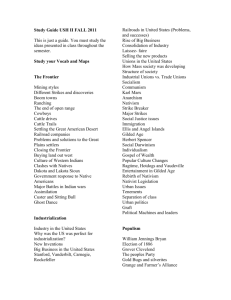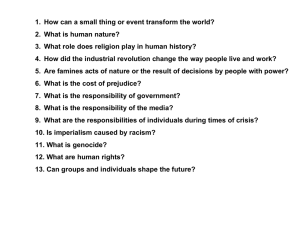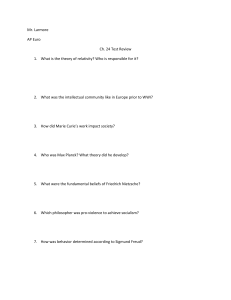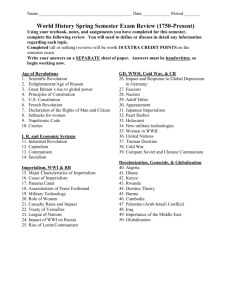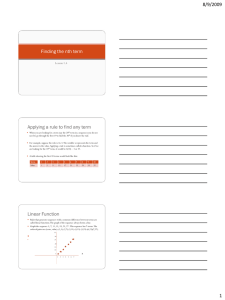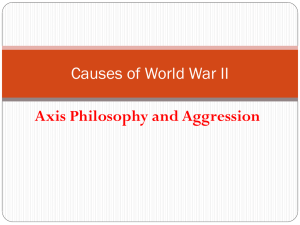World History II- Meyers Name_________________________
advertisement
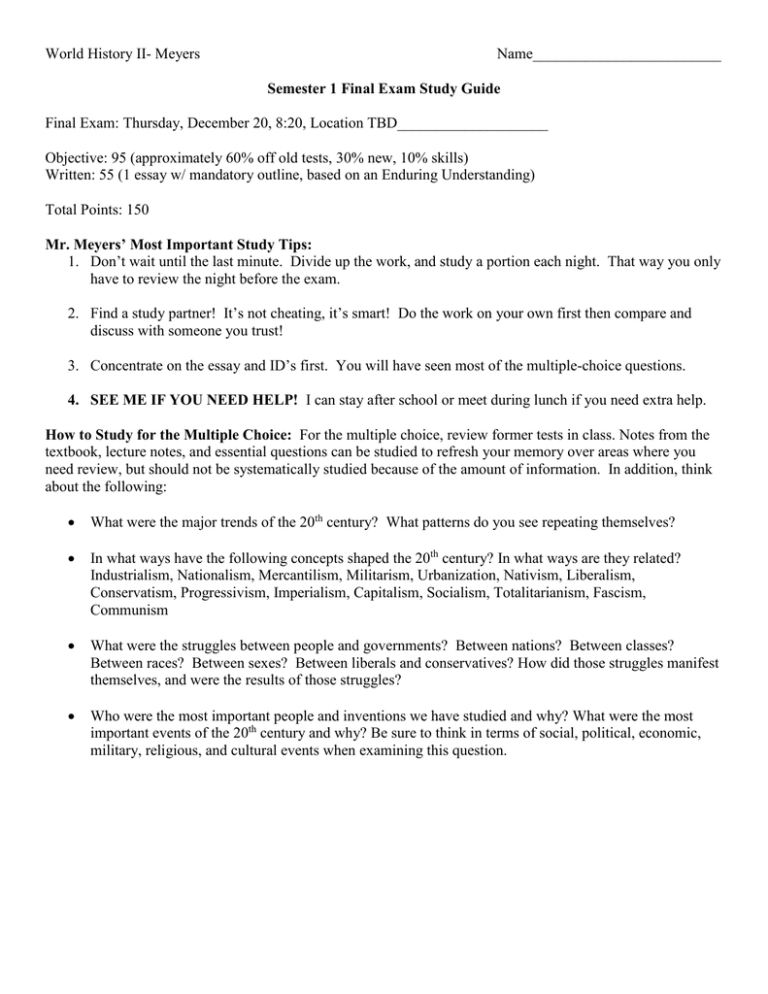
World History II- Meyers Name_________________________ Semester 1 Final Exam Study Guide Final Exam: Thursday, December 20, 8:20, Location TBD____________________ Objective: 95 (approximately 60% off old tests, 30% new, 10% skills) Written: 55 (1 essay w/ mandatory outline, based on an Enduring Understanding) Total Points: 150 Mr. Meyers’ Most Important Study Tips: 1. Don’t wait until the last minute. Divide up the work, and study a portion each night. That way you only have to review the night before the exam. 2. Find a study partner! It’s not cheating, it’s smart! Do the work on your own first then compare and discuss with someone you trust! 3. Concentrate on the essay and ID’s first. You will have seen most of the multiple-choice questions. 4. SEE ME IF YOU NEED HELP! I can stay after school or meet during lunch if you need extra help. How to Study for the Multiple Choice: For the multiple choice, review former tests in class. Notes from the textbook, lecture notes, and essential questions can be studied to refresh your memory over areas where you need review, but should not be systematically studied because of the amount of information. In addition, think about the following: What were the major trends of the 20th century? What patterns do you see repeating themselves? In what ways have the following concepts shaped the 20th century? In what ways are they related? Industrialism, Nationalism, Mercantilism, Militarism, Urbanization, Nativism, Liberalism, Conservatism, Progressivism, Imperialism, Capitalism, Socialism, Totalitarianism, Fascism, Communism What were the struggles between people and governments? Between nations? Between classes? Between races? Between sexes? Between liberals and conservatives? How did those struggles manifest themselves, and were the results of those struggles? Who were the most important people and inventions we have studied and why? What were the most important events of the 20th century and why? Be sure to think in terms of social, political, economic, military, religious, and cultural events when examining this question. Enduring Understandings for American and World History EU#1: The United States gradually became a global superpower during the 20th century. Examples of American Power Causes of American Power Effects of American Power EU#2: American society and culture has changed throughout the 20th century. Examples of Societal Change Causes of Societal Change Effects of Societal Change EU #3: Challenges to pre-existing social, economic, and political systems shaped 20th century W. History. What is a “system”? Social systems: Impact on World History: Challenges to social systems: Political systems: Impact on World History: Challenges to political systems: Economic systems or movements Impact on World History: EU #4:Conflict and cooperation between peoples and nations shaped 20th century World History. Examples Conflict Cooperation Cause Effect Unit 1: The Gilded Age and Progressive Era Essential Questions for Unit 1 1. 2. 3. 4. How did Progressive reformers respond to problems of the Gilded Age? How did the industrial revolution and the labor movement influence each other? How did the role of government change during the Progressive Era? How does The Jungle represent various aspects of the Progressive Era? Text Readings: BL 348-352, BL 418-443 Essential Topics: Gilded Age, Industrialism. Urbanization, Progressivism, Socialism, Social Darwinism, Liberalism, Conservatism, suffrage, immigration, democracy, nativism, big business, socialism, capitalism Other: Teddy Roosevelt, Woodrow Wilson, 17th and 19th Amendments, initiative, referendum, recall, direct primary, city-manager plan, Chicago, meatpacking, muckrakers, Upton Sinclair, Pure Food and Drug Act, John D. Rockefeller, Andrew Carnegie, Child Labor, Temperance, Big Business, Trusts / Monopolies, Vertical / Horizontal Integration, Labor Unions (tactics used against them, first successful labor unions, labor summary), Samuel Gompers, Knights of Labor, Haymarket Square Riots, Conservation, “New Freedom” vs. “New Nationalism,” Clayton Anti-Trust Act, Legacy and Limits of Progressivism, Jane Addams, Alice Paul, Margaret Sanger, WEB Dubois Unit 2: Imperialism, World War I and the Russian Revolution Essential Questions for Unit 2 1. 2. 3. 4. 5. 6. What are the various causes of imperialism around the world? Why did the United States become involved in foreign imperialism? What caused the Great War? Why was this global war more destructive and widespread than previous wars? What were the immediate results of the end of the war? What were the causes and results of the Russian Revolution? Text Readings: GR 728-734, BL 392-397, BL 399-405, BL 406-413, GR 800-805, GR 806-817, BL 448-455, BL 456-463, GR 824-831 Essential Topics: Imperialism, market, Nationalism, Militarism, Brinkmanship, Communism, front, trench warfare, conscription, Lost Generation, mandate system, treaty / armistice Other: Alliance System, National Rivalries, mass-production, total war, war of attrition, command economy, propaganda, revolution, self-determination, Direct / Indirect Rule, Raw Materials and Markets, Opening of Japan, Gunboat / Big-Stick / Dollar Diplomacy, Anglo-Saxonism, Importance of Navy and Alfred Thayer Mahan, Scramble for Africa, White Man’s Burden, Annexation of Hawaii, Spanish-American War, Panama Canal, Roosevelt Corollary, Teddy Roosevelt, Militarism, Assassination of the Archduke, mobilization, conscription, Balkan powder keg, Ottoman Empire as “sick man of Europe,” Schlieffen plan, Western Front, new weapons of WWI, trench warfare, “over the top,” “no man’s land,” Zimmerman Telegram, Unrestricted Submarine Warfare, Lusitania, Sussex Pledge, John Pershing, War Production Board, Wilson and the 14 Points, League of Nations, Treaty of Versailles, Alien and Sedition Acts / Schenck v. U.S., Selective Service Act, changes on the homefront, Lenin, Stalin, Provisional Government, Tsar Nicholas II and Tzarina, Rasputin, 4 phases of Russian Revolution, Animal Farm Unit 3: The Period Between the Wars Essential Questions for Unit 3: 1. What was the long-term impact of WWI on countries around the world? 2. How was the 1920’s a period of expansion of rights and restrictions of freedoms for some groups in the United States? 3. What was the impact of the “new economy” on values, attitudes, and behavior? 4. What are the causes of the Great Depression? 5. How did various countries around the world react to the challenges of the Great Depression? Text Readings: BL 480-488, BL 492-495, BL 530-534, BL 535-539, BL 542-546, BL 550-555, BL 566-577, GR 835-842, 850-858 Essential Topics: Red Scare, Roaring 20’s, speculation, stock market, business cycle, gross domestic product, inflation, Keynesian economics, New Deal, social welfare, totalitarianism, fascism Other: Shift from War to Peace, Spanish Flu, Nativism, “100% Americanism,” Sacco and Vanzetti, eugenics, KKK, Scopes Trial, National Origins Act of 1924 and Immigration Quotas, New Morality, flappers, 21st Amendment ending Prohibition, art / literature, Baseball and Babe Ruth, Hollywood, radio, jazz, Louis Armstrong, Harlem Renaissance, Henry Ford, Chalres Lindbergh, WEB Dubois, Booker T Washington, Marcus Garvey, NAACP, Bull Market, margin / margin call, Herbert Hoover, Laissez Faire economics, Black Tuesday, Causes of the Great Depression, ALL concepts on the Economics 101 Glossary filled out in class, breadlines, Dust Bowl, Hoovervilles, Charlie Chaplin, Dorothea Lange, Jacob Lawrence, Woody Guthrie, Bonus Army, Election of 1932, FDR, 100 Days, New Deal and ABC programs (see ABC chart), 3 R’s, 3 areas targeted in U.S. economy, Legacy of the New Deal (Broker state, Welfare state, role and size of federal government, criticisms from the left and right), Keynes, Deficit Spending, Dawes Plan, Weimar Republic, Adolf Hitler, Benito Mussolini, Nazi’s, Socialism, Communism, Totalitarianism Unit 4: World War II Essential Questions for Unit 4 1. 2. 3. 4. 5. What were the causes of WWII? How did the Allied Powers defeat the Axis Powers? How did WWII change or influence U.S. society? What were the immediate results of WWII? What is genocide? Why does it happen? Text Readings: BL 584-588, 601-606, 618-623, 631-635, 635-639, 640-648 Essential Topics: total war, allies, axis, Nazism, neutrality, appeasement, blitzkrieg, lebensraum, war crimes, genocide, holocaust, United Nations Other: Mein Kampf, Rome-Berlin Axis, Allies, Anschluss, Sudetenland, Munich, Russo-German NonAggression Pact, JA Invasions of Manchuria, China, Dutch East Indies, Greater East Asia Co-Prosperity Sphere, U.S. Embargo Act, Neutrality Acts of 1935-37-39, Destroyers-For-Bases, America First Committee, Lend-Lease Act, Atlantic Charter, Pearl Harbor, War Production Board, Selective Service and Training Act, Segregation / Double “V”, Women’s role, General MacArthur and the Philippines, Neville Chamberlain, Winston Churchill, Hideki Tojo, Bataan Death March, Battles of Coral Sea and Midway, Stalingrad, Rosie the Riveter, Migrations of people (blacks and Hispanics), Japanese-American Internment Camps, Rationing, Victory Gardens, War Bonds, D-Day (Overlord), Island-Hopping, Kamikaze, Battle of the Bulge, End of WWII, A-Bomb (effects and arguments for / against usage), Evolution of Holocaust / War Crimes
